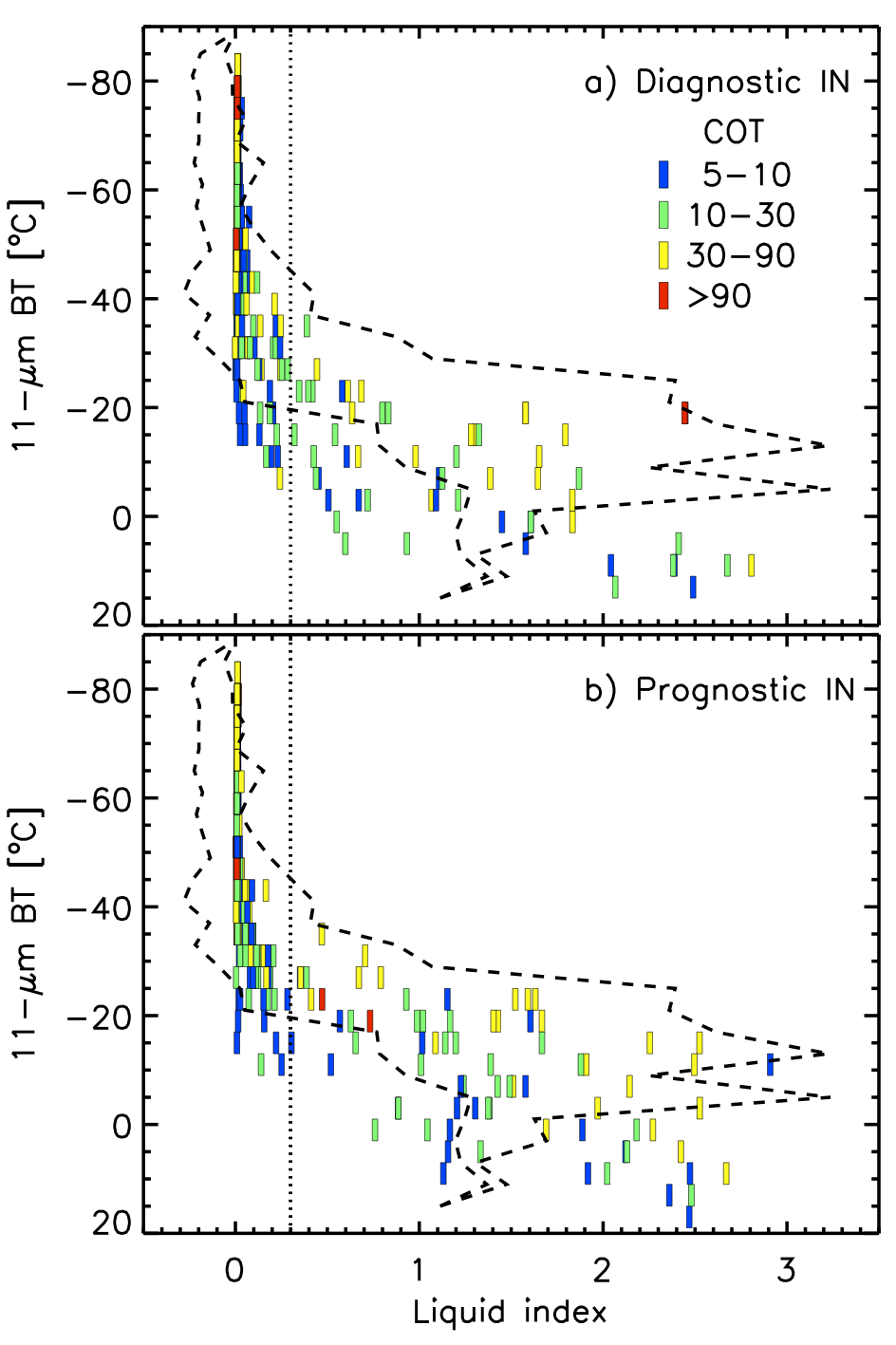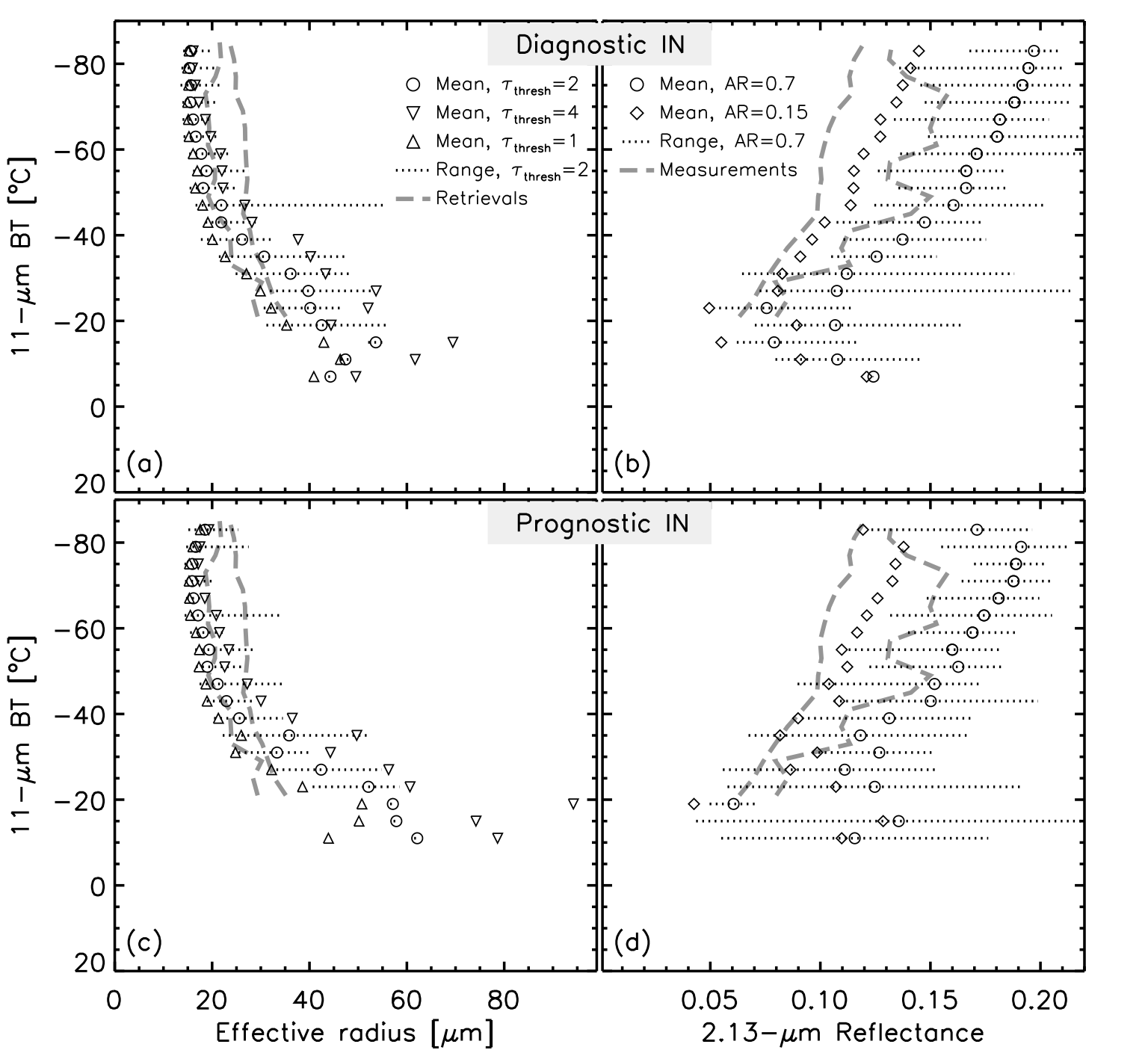Satellite Constraints on Cloud-Top Phase, Ice Size, and Asymmetry Parameter Over Deep Convection
Submitter:
van Diedenhoven, Bastiaan — SRON - Netherlands Institute for Space Research
Fridlind, Ann M. — NASA - Goddard Institute for Space Studies
Area of research:
Cloud Processes
Journal Reference:
Science
Intensive field campaigns have provided a wealth of in situ measurements that have proven to be invaluable for constraining and evaluating cloud-resolving model (CRM) simulations. However, some important diagnostics related to ice formation processes, such as ice crystal size and glaciation temperature, remain uncertain owing to issues such as poor spatiotemporal coverage and shattering of large ice crystals on aircraft probe inlets.
Satellite remote sensing measurements have more extensive coverage and obviously avoid in situ probe challenges, but retrieval algorithms generally include many a priori assumptions, and the retrieval products are often not straightforward to interpret. For instance, it is often not obvious to what cloud depth an effective radius (Reff) retrieved from near-infrared satellite measurements pertains. Moreover, assumptions about ice crystal shapes and microscale crystal roughness also strongly influence the retrieved Reff. Finally, cloud phase retrieval algorithms generally perform poorly over mixed-phase and multi-layered clouds, which hampers robust retrievals of cloud properties in such cases.
In this study, we demonstrate how satellite observations of multidirectional total and polarized reflectances can be used to robustly evaluate CRM simulations of tropical deep convection in terms of ice crystal sizes and glaciation temperature. We develop a framework that avoids inconsistencies between assumptions made in retrieval algorithms and the CRM by forward-calculating total and polarized reflectances in a manner consistent with the model assumptions and output. Then forward-calculated and observed reflectances are directly compared. The measurements and simulations are based on the TWP-ICE campaign in 2006. Two simulations are included in this study: one uses a diagnostic ice nuclei (IN) approach, which assumes a constant total number of ice crystals and nuclei, and the other uses a prognostic IN approach, which allows for local consumption and removal of IN.
Impact
First, multidirectional polarized reflectances measured by the POLDER instrument are used to constrain the thermodynamic phase of the cloud tops. Here, we utilize the prominent difference in directional polarized reflectance from spherical cloud drops, which produces a strong rainbow feature around 140 degree scattering angle, versus nonspherical ice particles, which show little or no structure at these scattering angles. The polarization measurements indicate only ice-topped clouds at brightness temperatures (BTs) smaller than -40°C, only liquid clouds at BT > -20°C, and both phases occurring at temperatures in between. The polarized reflectances calculated from model simulations generally reveal too many ice-topped clouds at BT > -20°C, especially in the simulation with diagnostic IN.
For those clouds identified as topped with ice, multidirectional polarized reflectances are then also used to constrain ice crystal geometry and asymmetry parameter. The CRM assumption of platelike ice crystals with an aspect ratio of 0.7 is found consistent with POLDER measurements for BT < -40°C when very rough ice crystals are assumed, leading to an asymmetry parameter of 0.74. At warmer temperatures, however, measurements indicate more extreme aspect ratios of ~0.15, yielding an asymmetry parameter of 0.84.
After determining the cloud phase and ice crystal geometry, next we turn to near-infrared reflectances measured by MODIS to constrain the simulated Reff. MODIS-retrieved Reff are found to be 18–28 micron at BT < -40°C, but biased low by about 5 micron owing primarily to the assumption of pristine crystals in the retrieval. At BT > -40°C, retrieved Reff are generally about 5–10 micron larger. However, based on the very distinct polarization measurements between cold and warm ice clouds, we argue that this increase of retrieved Reff at warm temperatures may partly be a retrieval artifact caused by the use of an ice model that does not depend on temperature. For a robust evaluation of the modeled ice sizes at cloud top, we use forward-calculated 2.13-micron reflectances, which are simulated using the same assumptions about ice volume, projected area, and shape as used in the ice microphysics calculations. Simulated 2.13 micron reflectances at BT < -40°C are found to be too large compared to measurements, suggesting that model-simulated effective radii are 7–15 micron too small. At warmer temperatures, the simulated 2.13-micron reflectances indicate less bias but stronger variation in the ice sizes for both simulations.
Summary
The two simulations with contrasting ice nucleation schemes show little difference in simulated ice sizes at BT <: -40°C, indicating that homogeneous nucleation is dominating in the simulations. Interestingly, changes around -40°C in satellite observations suggest a change in cloud-top ice shape and/or size in natural deep convection possibly related to a change in the freezing mechanism.



